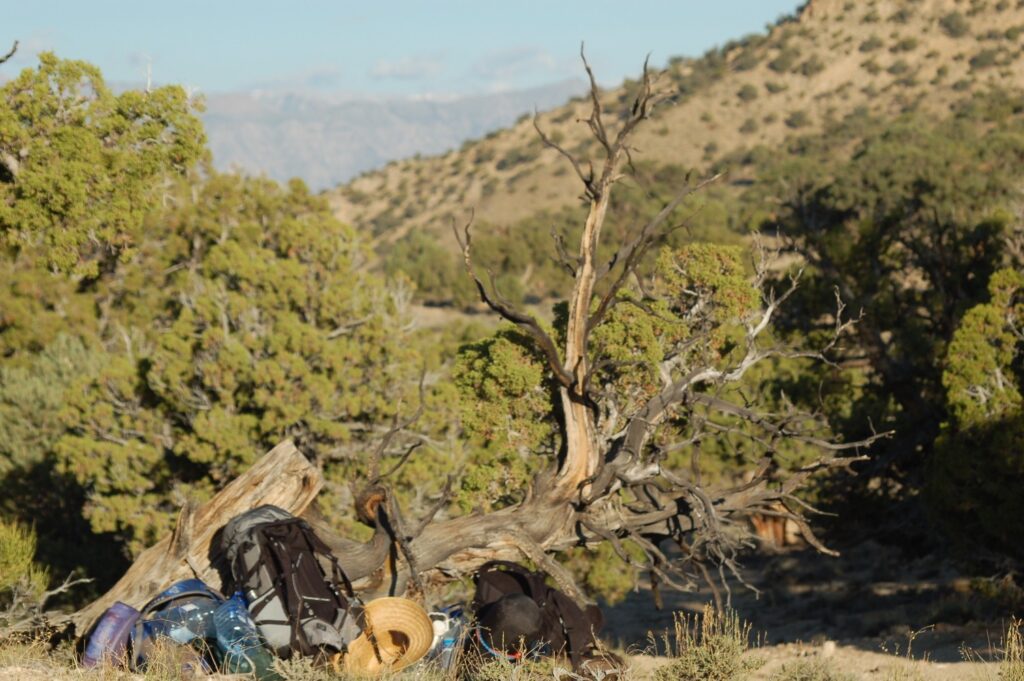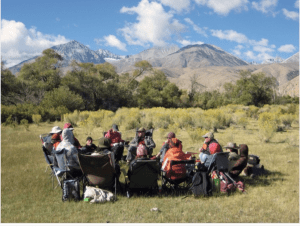
How to Prepare for Your Vision Fast Ceremony
Most likely you are reading this because you have signed up for a vision fast. Or maybe you are just flirting with the idea, wondering if this crazy business of fasting for four days and nights, alone in nature, is the right thing for you. “What” you may ask, “is the point of putting oneself through such hardship and risk?”And yet, perhaps, even with the doubts and worries, something is tugging at you, trying to pull you across the border and into your life. If you are ready to take the step, read on.
Why a Rite of Passage?
In our fast-paced culture, we see an increasing desire for quick and easy transformation. This is evident by the multitude of self-help books and weekend workshops available today, many which tantalize with the promise of a happier, more satisfied life. While we appreciate much of what is offered to those who hunger for a better life, we also know that transformation is almost never quick and certainly not easy. This has been true of rites of passage throughout the ages. In fact, a rite of passage may not make life easier at all, but rather, more difficult. To step into one’s life fully, to take on one’s shadows and gifts, can invite intense challenges and turn one’s life completely upside down! Nevertheless, there is ultimately more to lose in living a half-life rather than facing the agony and joy of the initiate’s path toward wholeness. Deep down, we know this. It’s in our bones. It is ancient knowledge passed down through our psychic DNA.
Initiatory rites of passage are as old as dirt. Deeply tuned in to the cycles of nature, ancient societies around the world created rituals of initiation to mark, celebrate, and make sense of the great mysteries of life, death, and rebirth. Although, the primary rite of passage is marking the transition from childhood to adulthood, we go through a variety of transitions through every stage of life, from birth to death; each one confronting us with the goal (again) to become more of who we are, and ultimately to prepare for death. By enacting rites of passage, we continually imitate the death and rebirth patterns of nature. Through each seasonal cycle, we remember that we are nature.
Throughout recent history, culminating in modern culture, humans have perceived themselves more and more separated from the natural world, and thus, less inclined to practice the initiatory rites of our ancestors. In today’s world, we find little community awareness and support for these critical transitions. Our instinctive need for initiation has been forced underground, into the unconscious, only to show up later in self-destructive behaviors and ecological and community devastation. Addictions, pointless violence, and out of control consumerism are just a few symptoms of this loss. We feel, therefore, that the modern day renewal of rites of passage is essential not only for the health of the individual, but also for the health of our communities and for the planet.
What is a Vision Fast? Severance – Threshold – Incorporation
Just as nature moves according to its inborn patterns, so does the rite of passage ceremony. Without form, the ceremony lacks meaning. Having studied ancient cultures worldwide, anthropologists have identified an archetypal pattern that permeates throughout most rites of passages. Although a rite of passage may take years to complete, the vision fast ceremony offers a strong and meaningful way to support this transition. If you decide to become a candidate for the vision fast, you will be guided through the three phases of this pattern.
The first phase is called severance. Severance is the time it takes to prepare for the vision fast and entails a deep listening to oneself, asking “What do I need to sever from in order to emerge anew?” For the person facing initiation into adulthood (no matter what age), this means severing from childhood, from the mother, father, and from home. For others, severance may entail the long preparation of saying “good-bye” to that which no longer serves their life: A partner, a job, a status position, or some other intangible attitude or way of being. This can be a long and painful process of letting go, but it’s also a needed lightening of the load before taking a long journey.
The second phase is called the threshold or the in-between place. This happens when you step across the threshold and find yourself in the realm between your old life and its limits, and the new life that is not yet fully known. Within the vision fast ceremony, the threshold is the time when you are fasting, alone in nature for four days and nights. It is characterized by the uncertainty of stepping into the unknown and leaving everything and everyone behind. This can be both frightening and euphoric or, in some cases, lonely or boring, with spells of sudden and moving emotions. In any case, this is your ceremony, and no matter how it pans out, it will be just what it is meant to be.
The third phase is the incorporation, which literally means “taking into the body”. We call this “making it real”. What is the point of embarking on a vision fast, of going to the sacred mountain, if you do not bring back the boon for your people? When you return from the fasting threshold you are reunited with your community; first with those in the fasting group and your guides, who mirror your story and gifts, and finally, with your community at home whoever that might be. Perhaps this is the most difficult and prolonged phase of them all, and yet, it is also the most vital and exciting. For during incorporation, you bring your gifts to the world; not just for yourself but for those who will benefit from the individual that you have become.
How to Prepare for your Ceremony
We ask that you take your preparation seriously. Ideally, you’ll give yourself months, if not a full year, to prepare for your ceremony. The more time and effort you take to prepare, the more meaningful your ceremony will be. It is important to keep in mind that the vision fast ceremony is not a quick-fix deal. It is a practice that demands your full attention and commitment. It is likely that during your preparation phase, you’ll feel frightened, inadequate, or that you’re not up to the task. All of these feelings can indicate, paradoxically, that you’re on the right path. On the other hand, if it feels overwhelming, you may need to step back and reflect; perhaps talk with one of the guides about your readiness.
Preparing for Death
All rites of passage entail a psychological death, which is no less than a radical altering in one’s identity; a shattering, or dissolving, of self-image that reverberates all the way down to the bedrock of the soul. Such a death is necessary for the rebirth; the new way of being that follows. Imagine, therefore, that in preparing for your upcoming vision fast, you’re also preparing for death. What old ego-identity is waiting to die? Who do you need to “make it good” with in order for you to fully step through the threshold? What sacrifices need to be made so that the new life that awaits can come in cleanly and freely? In other words, how can you best prepare for your death? For some, these questions may foster a great deal of anxiety. For others, who have already faced death in some way, they may entail a confirming, or a reaffirming, of what is already present and true.
Planning your Ceremony
Another step in preparing for your ceremony is to deeply engage the question, “What is my intent for my upcoming ceremony?” In other words, right now, and from the deepest place in your psyche, what can you say about that which is compelling you to embark on this vision fast? Referring to the three phases of rites of passage, Steven Foster and Meredith Little offer the following questions for helping formulate an intent.
- Do I want to mark a severance (separation, termination, parting, letting go, conclusion)?
- Do I want to mark a threshold (transition, change, adjustment, shift in role, status, or task, period of extended depression, transformation, renewal)?
- Do I want to mark an incorporation (return, joining, union, reestablishment of harmony, new responsibilities, new beginnings)?
Identifying your intent and creating a meaningful ceremony for yourself can be challenging, and most likely your intent will shift and change as the vision fast draws closer. During the four days preceding your fasting/solo time, your guides will help you further clarify your intent, which can be a process as powerful and profound as the actual fast itself.
The Solo Walk
The solo walk is a tool to help you clarify your intent, preferably done about a month before your actual vision fast. We recommend that you begin your walk at sunrise and end at sunset, although there are no hard fast rules about this. Any intentional time you spend on the land, alone and without food or shelter, is in service to your upcoming ceremony. Begin your walk by crossing a threshold, a physical or imaginary line, as you enter into your dreamscape where all that you encounter speak with the voices of the spirits of the land. The “voices” may be obvious or they may be subtle, speaking through the soft wind in the trees or even the rattling of a rusty tin can. They may come in the form of memories or indirect thoughts. The task is to pay attention to all that is present.
During your walk you may find something, a symbol, which is particularly important to you, or resembles you in some way. You may want to bring this to your vision fast to help further clarify your intent when working with your guides.
Safety is of upmost importance during any solo time. Please make sure you have plenty of water, good directions, the right clothing and gear, and that someone knows of your whereabouts. Also, see the handbook, “The Trail to the Sacred Mountain” for more information on safety.
Equipment and Physical Preparation
Physical preparation is a central part of the ceremony, just as much as any psychological or spiritual preparation. You’ll notice this once you begin to gather your backpack, sleeping bag, tarp and all else you’ll need for your solo time. Give yourself plenty of time for your physical preparation. We recommend that you carefully go through the equipment list in the handbook and diligently mark off each item.
Nature is not an abstraction. If unprepared, rain and cold can cause hypothermia, the sun can burn skin, and snakes and scorpions can bite. But, the truth of nature is what makes your solo time real, mysterious, and meaningful. Thank goodness there is no such thing as a virtual vision fast! Good preparation and some basic knowledge will help you stay safe. Be tuned into what your body needs. If you have a medical condition or are taking any medication, let your guides know beforehand. Your guides will also help you prepare physically for your solo time, but we encourage that you read the handbook carefully before you arrive and check with your physician if you have any concerns.
Are You Ready?
“Initiation causes a funeral and a birth; a mourning appropriate to death and a joyous celebration for the restoration of a full life”, writes mythologist Michael Meade.
So, are you ready to die? Are you ready to be reborn more fully into life?
If you’ve read this far, it may be too late. The call of the ancient mysteries of initiatory rites of passage is already demanding your attention. Once headed, there is little chance of turning back. But take your time; listen for what is right for you.
Or, as Steven Foster always said, just forget that this crazy idea ever came into your mind.
Just try.
Recommended Reading:
The Trail to the Sacred Mountain: A Vision Fast Handbook for Adults (also available for youth).
This can be purchased from Lost Borders Press.
Share This
Related posts




